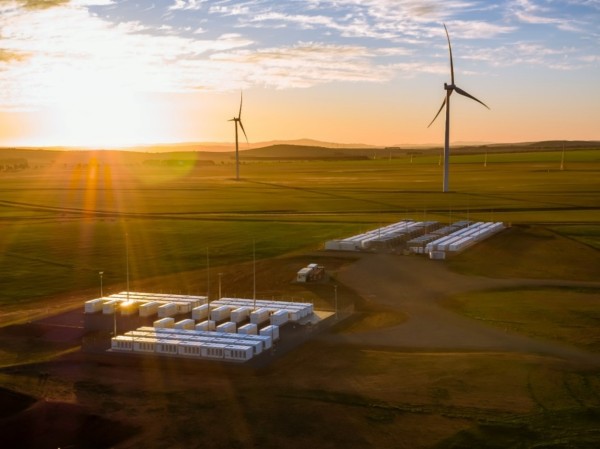Cigre Australia
empowering
networking
global know-how
South Australian Battery Energy Storage Case Studies
A new working group, C1.51 is well underway and an article on two grid-scale battery energy storage systems in South Australia has recently been added to the draft Technical Brochure. This article, provided by Rainer Korte from ElectraNet, illustrates how Australia is playing a leading role in the growth and support of renewable energy.
Unlike other jurisdictions with high penetration of renewable energy, South Australia predominantly relies on wind and solar generation, has no hydroelectricity, pumped hydro, or nuclear power and remains weakly interconnected with the rest of the Australian National Electricity Market.
South Australia now operates at 75% net annual variable renewable energy and is on track to reach 100% by 2027.
Energy storage has a very significant role to play in successfully operating a high variable renewable energy power system like the one in South Australia.
Dalrymple Battery Energy Storage System

Dalrymple 30MW, 8MWh Battery Energy Storage System in South Australia.
The groundbreaking Dalrymple 30 MW, 8 MWh Battery Energy Storage System (BESS) was the first transmission grid-connected battery in the Australian National Electricity Market (NEM) to provide both regulated and competitive market services.
The $30 million BESS project has been in full commercial operation since December 2018 and is located at the end of a long radial 132kV transmission line.
The success of the project required significant innovation leadership including:
- Development of a first-of-its-kind commercial model to support the provision of regulated reliability and security services by a Network Service Provider (ElectraNet) alongside competitive market services from AGL, challenging perceived limitations to network ownership of battery energy storage technologies.
- Navigating the market registration, licencing and connection processes for the first time paving the way for others to follow.
- Development of the largest autonomous regional micro-grid at the time, co-optimised for both grid-connected and islanded operation with 100% renewables allowing seamless transition between the two operating modes (for both planned and unplanned islanding).
- Provision of pre-emptive emergency response as part of the South Australian System Integrity Protection Scheme (SIPS), providing fast power injection into the network following a significant loss of generation to help prevent a major loss of supply to customers.
- Supply of Fast Frequency Response to help balance the electricity network and reduce operating constraints on the Heywood interconnector between South Australia and the rest of the National Electricity Market.
- Keeping the lights on in the Dalrymple service area during a loss of supply by working together with the 90MW Wattle Point Wind Farm and local rooftop solar PV systems in a seamless microgrid arrangement.
In this way the BESS supports the delivery of affordable, reliable, secure and sustainable energy to customers.
The Dalrymple BESS was the largest ‘edge-of-grid’ application that can seamlessly island the local distribution area (8 MW peak demand) and has demonstrated how the reliability of ‘edge-of-grid’ communities can be improved.
More information including photos is available at:
Dalrymple ESCRI-SA Battery Project – ElectraNet
Good video summaries are available here:
Dalrymple battery celebrates 5-year anniversary – ElectraNet | https://youtu.be/psMKc0b5esI
Hornsdale Power Reserve Battery

Neoen Hornsdale Power Reserve 150MW, 193.5MWh battery in South Australia.
Following the September 2016 state-wide blackout which left South Australia without power, Neoen and Tesla were selected by the South Australian Government to supply Australia’s first big battery named the Hornsdale Power Reserve (HPR).
HPR is located approximately 16km north of Jamestown in South Australia. With initial nameplate capacity of 100MW, 129MWh it was the world’s largest utility scale battery at the time of completion in December 2017.
The fast-ramping capability of the Tesla Powerpack systems used at HPR enables the facility to dispatch large amounts of power quickly and reliably. This supports the South Australian electricity grid and delivers major cost savings by providing frequency control and short-term network security services. A technical and market study carried out in 2018 by independent consultant Aurecon noted that the introduction of HPR has significantly increased competition in the regulation Frequency Control and Ancillary Services (FCAS) market, effectively reducing the cost of FCAS services. In its first two years, HPR saved South Australian energy consumers $150 million, thanks to its market capacity and the capacity reserved by the South Australia Government at low cost.
Hornsdale Power Reserve primarily functions in the NEM, participating in the energy market for arbitrage, as well as ten FCAS markets.
Alongside this, HPR reserves capacity for key grid services, including, Fast Frequency Response and Network loading control ancillary services (NLCAS)
The HPR expansion project (HPRX) commenced construction in November 2019 and completed commissioning in September 2020 to expand HPR to 150MW, 193.5MWh.
This Australian-first battery expansion project committed to trial a new virtual inertia operating mode or Virtual Machine Mode (VMM), which mimics the behaviour of a synchronous generator when responding to rapid changes to frequency, stabilising the grid when electricity supply and demand unexpectedly fluctuate.
HPRX included the implementation of VMM, with a view to providing utility-scale virtual inertia services to the South Australian grid. The test plan involved a staged approach, which commenced with small-scale bench testing of the Tesla Powerpack system operating in VMM through to the full implementation of VMM at the entire 150MW expanded HPR facility.
This can deliver numerous specific benefits to grid operators today, including improving system inertia, facilitating standalone operation, and adding voltage smoothing to weak grids.
HPR has been able to successfully demonstrate an inertial response to real system events in the Australian NEM, which was very close to that predicted by models.
Having successfully navigated the regulatory process for implementing VMM, HPR has effectively paved the way for other BESS to follow. The trial of VMM at HPR was a learning exercise for all project stakeholders and a first for a BESS of this size.
